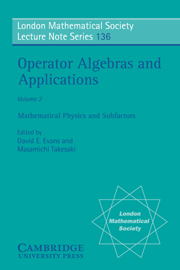Book contents
- Frontmatter
- Preface
- Contents
- UK-US Joint Seminar on Operator Algebras Lectures
- Some recent results for the planar Ising model
- The heat semigroup, derivations and Reynolds' identity
- C*-algebras in solid state physics: 2D electrons in uniform magnetic field
- Spin groups, infinite dimensional Clifford algebras and applications
- Subfactors and related topics
- Quantized groups, string algebras, and Galois theory for algebras
- On amenability in type II1 factors
- An index for semigroups of*-endomorphisms ofB(H)
- Coactions and Yang-Baxter equations for ergodic actions and subfactors
- Derived link invariants and subfactors
Quantized groups, string algebras, and Galois theory for algebras
Published online by Cambridge University Press: 16 March 2010
- Frontmatter
- Preface
- Contents
- UK-US Joint Seminar on Operator Algebras Lectures
- Some recent results for the planar Ising model
- The heat semigroup, derivations and Reynolds' identity
- C*-algebras in solid state physics: 2D electrons in uniform magnetic field
- Spin groups, infinite dimensional Clifford algebras and applications
- Subfactors and related topics
- Quantized groups, string algebras, and Galois theory for algebras
- On amenability in type II1 factors
- An index for semigroups of*-endomorphisms ofB(H)
- Coactions and Yang-Baxter equations for ergodic actions and subfactors
- Derived link invariants and subfactors
Summary
We introduce a Galois type invariant for the position of a subalgebra inside an algebra, called a paragroup, which has a group-like structure. Paragroups are the natural quantization of (finite) groups. The quantum groups of Drinfeld and Fadeev, as well as quotients of a group by a non-normal subgroup which appear in gauge theory have a paragroup structure.
In paragroups the underlying set of a group is replaced by a graph, the group elements are substituted by strings on the graph and a geometrical connection stands for the composition law. The harmonic analysis is similar to the computation of the partition function in the Andrews-Baxter-Forrester models in quantum statistical mechanics (e.g. harmonic analysis for the paragroup corresponding to the group ℤ2 is done in the Ising model.) The analogue of the Pontryagin van Kampen duality for abelian groups holds in this context, and we can alternatively use as invariant the coupling system, which is similar to the duality coupling between an abelian group and its dual.
We show that for subfactors of finite Jones index, finite depth and scalar centralizer of the Murray-von Neumann factor R the coupling system (or alternatively the paragroup) is a complete conjugacy invariant. In index less than 4 these conditions are always satisfied and the conjugacy classes of subfactors are rigid: there is one for each Coxeter – Dynkin diagram An and D2n and there are two anticonjugate but nonconjugate for each of the E6 and E8 diagrams.
Information
- Type
- Chapter
- Information
- Operator Algebras and Applications , pp. 119 - 172Publisher: Cambridge University PressPrint publication year: 1989
Accessibility standard: Unknown
Why this information is here
This section outlines the accessibility features of this content - including support for screen readers, full keyboard navigation and high-contrast display options. This may not be relevant for you.Accessibility Information
- 79
- Cited by
